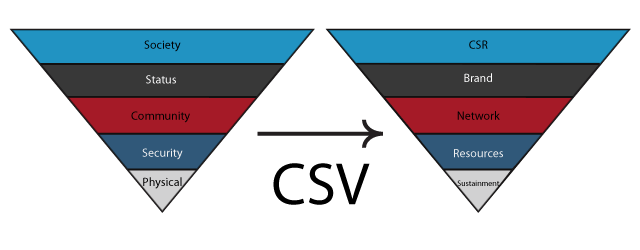
While attending the Business Startup show in London, I heard a speech given by Penny Power which highlighted the importance of relationships between businesses and their communities. Societies globally are increasingly becoming integrated networks thanks to advances in technology allowing more communication and transparency. Companies are finding themselves in a crossroads between perpetuating old values and adopting new ones; times are changing and new strategies are needed to address a new environment. As a result, success within capitalism is forced to move towards a new equilibrium of mutual benefit, derived from cooperation in game theory, and away from selfish motivators.
Creating Social Value
Michael Porter wrote an article in the Harvard Business Review describing how companies new strategy should involve moving away from Corporate Social Responsibility (CSR) towards aligning all departments to Create Shared Value (CSV). The rise of CSR departments are proof that society is also increasingly becoming motivated by these social values, yet these CSR departments are not at the core function of the businesses. Additionally, the financial crisis helped to shift companies away from short term gains towards long term results; either through regulation to incorporate negative externalities or through companies adopting CSR initiatives to capture positive externalities for their brand images. Moreover, the way economic success is measured is even changing, from a shift solely looking at GDP and GNP towards GPI which factors in social issues like quality of life. The shift follows the same transition from a transactional business model to a social and supportive business model where client relationships are key to success. Previous financial bottom-line analysis must now incorporate indicators that measure a company’s success and failure on issues surrounding society and the environment, devising a new triple bottom-line.
Maslow topsy-turvey
Interestingly enough, Penny Power pointed out that Maslow’s famous hierarchy needs have been inverted in modern times and redefine keys to a company’s success. As such, the process works as follows: by cooperating, reciprocating and showing concern for society and the environment, you can manifest relationships that can insure business success, which can provide status, community bonds and basic physical needs.
Social Capital
Social capital can be divided into industry and client segments. Client segments can define social capital among an enterprise and clients, while industry segments can define social capital among businesses. Social capital would comprise of the following:
- Shared norms
- Similar or shared use of communication channels
- Reciprocity or mutual benefits from using a service or product
- A company’s ability to use and acquire formal and informal networks
- Shared commitment to belonging
- Trust
Client focus
Over the past few years, the success of Salesforce.com shows how Customer Relationship Management (CRM) departments are increasingly important in every type of business as companies migrate towards customer-centric models. Businesses are recognizing the need to develop and maintain relationships with their clients, as those relationships will define the key driver to success. The main component of this relationship revolves around a centralized theme that businesses understand and care for their clients needs, wants and …. values!
Thus, businesses must move away from broadcasting monologue messages, to a customer dialogue where companies listen to clients’ needs and thereby develop deeper relationships. Blogs have become one tool companies can exploit to provide a platform for the dialogue to occur, but other forms of communication with the client can also be beneficial that can both engage clients and involve them in social initiatives not purely restricted to a company’s product or service.
We think, therefore you are
By using social tools to engage in dialogues and create social awareness, companies can create followers who share their values and support business to re-affirm and embolden their own values. Richard Dawkins coined the the term “memes” to define ideas a sort of cultural virus, which propagates itself as if it were alive. Similarly, peoples beliefs in social/cultural values are memes where clients would support businesses who brand themselves with the same beliefs in order to perpetuate these memes within society. Thus, when companies brand themselves with social values and engage with customers they add the personal touch necessary to change the relationship and a client’s perception from solely a service or product provider to also a friend. The effects from a deeper relationship manifest into word-of-mouth promotion; a low cost addition in a company’s marketing strategy. Companies can measure the success of such social campaigns by measuring the number of followers, their growth, and the amplification effect from word-of-mouth consequences. However, companies should focus on only one social cause which will define the social scope and integration into all aspects of the business. A more focused social cause will improve company alignment towards it’s desired social outcomes and prevented brand dilution.
Business focus
The old model of capitalism sought to create companies in direct competition with others as a sort of winner takes all game. However, business leaders are starting to see that value creation can be shared among all business players within an industry, and even across industries to help create common economies of scale, scope and knowledge. High technology companies in particular have created many research and development cooperative projects to help the success of all the industry. Thus, business communities can foster partnerships that can move away from squeezing suppliers and building barriers-to-entry for competitors, and towards relationships based on mutual outputs, goals, common interests and… values. A common goal towards creating social value can in itself create competitive advantages through increasing productivity and cooperation among businesses.
What is good for the gander, is good for the goose
Addressing social and environmental values within a community also helps companies to create alignment within all aspects of their internal supply chain and organizational processes. The company wide alignment creates profit maximization through streamlined processes and a focus on a triple bottom line rather than separate CSR department and company operational initiatives. The risks involved in incorporating social values into an end-to-end strategy, for long term results, could result in increasing costs and new standards. The new industry standards could later be incorporated into regulation and could be constantly challenged by competitors; causing continually increasing costs if business don’t end up cooperating. The trade off is that society values the pioneers of such new standards and also rewards those companies through positive sum games. In the end, companies focusing on CSV throughout their enterprise can reap big rewards for both themselves and society.


Leave a Reply